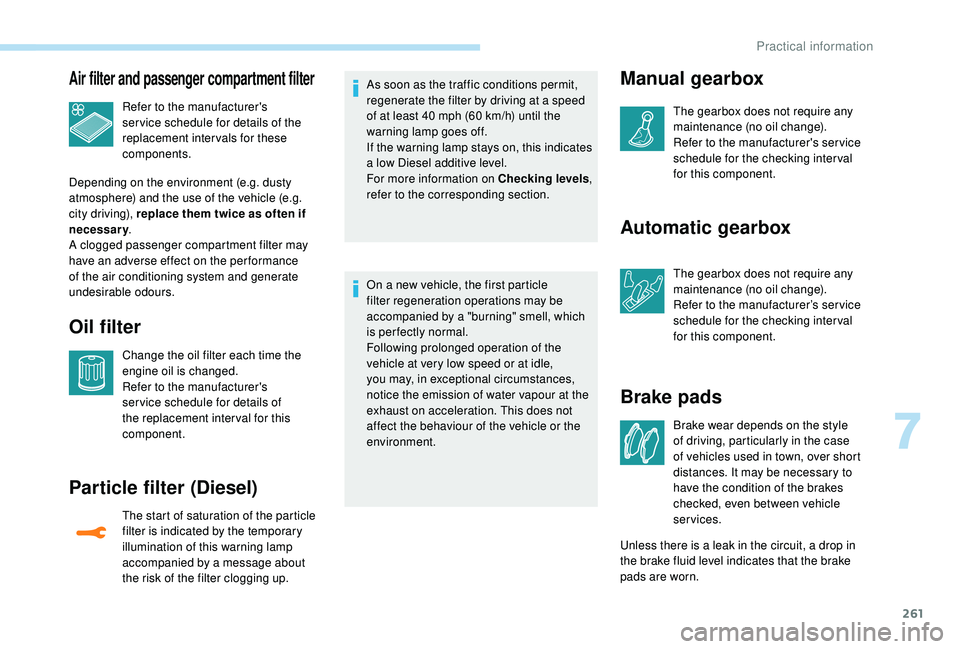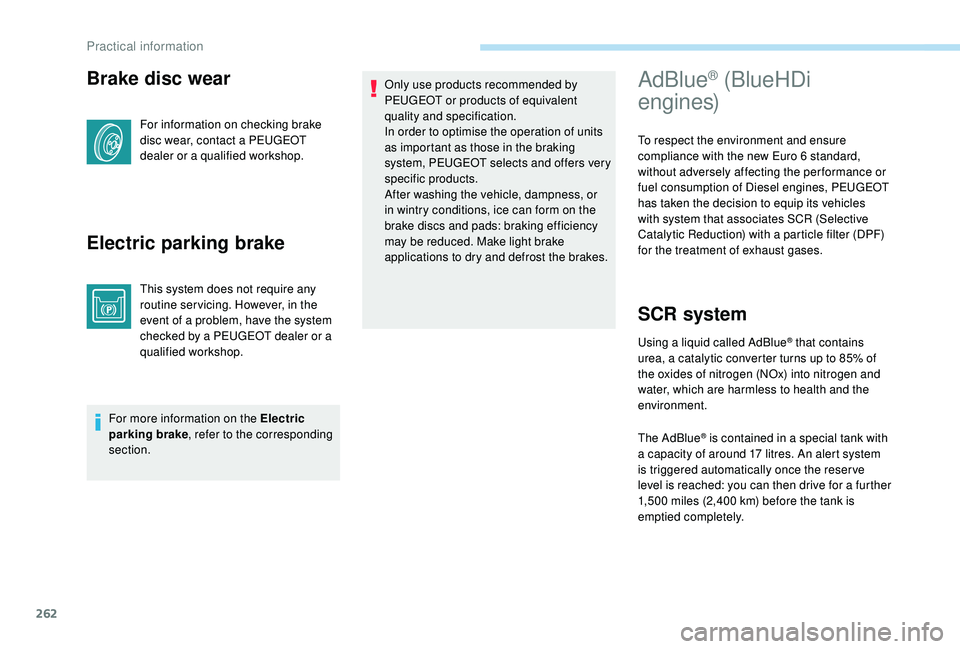2017 PEUGEOT 5008 brake pads
[x] Cancel search: brake padsPage 177 of 404

175
Driving recommendations
Observe the driving regulations and remain
vigilant whatever the traffic conditions.
Pay close attention to the traffic and keep your
hands on the wheel so that you are ready to
react at any time to any eventuality.
As a safety measure, the driver should only
carry out any operations that require close
attention when the vehicle is stationary.
On a long journey, a break every two hours is
strongly recommended.
In difficult weather, drive smoothly, anticipate
the need to brake and increase the distance
from other vehicles.Never leave the engine running in
an enclosed area without adequate
ventilation: internal combustion engines
emit toxic exhaust gases, such as carbon
monoxide. There is a risk of poisoning and
death!
In very severe wintry conditions
(temperatures below -23°C), to guarantee
correct operation and the longevity of
the mechanical elements of your vehicle,
engine and gearbox, the engine must be
left running for 4
minutes before driving.
Important!
Never drive with the parking brake applied
– Risk of overheating and damage to the
braking system!
As the exhaust system of your vehicle
is very hot, even several minutes after
switching off the engine, never park or run
the engine on inflammable sur faces (dry
grass, fallen leaves, etc.): Risk of fire!
Never leave a vehicle unsuper vised with
the engine running. If you have to leave
your vehicle with the engine running, apply
the parking brake and put the gearbox into
neutral or position N or P , depending on
the type of gearbox.
Driving on flooded roads
We strongly advise against driving on flooded
roads, as this could cause serious damage
to the engine or gearbox, as well as to the
electrical systems of your vehicle. If you are obliged to drive through water:
-
c
heck that the depth of water does not
exceed 15 cm, taking account of waves that
might be generated by other users,
-
d
eactivate the Stop & Start system,
-
d
rive as slowly as possible without stalling.
Under no circumstances exceed 6 mph
(10
km/h),
-
d
o not stop and do not switch off the engine.
On leaving the flooded road, as soon as
circumstances allow, make several light brake
applications to dry the brake discs and pads.
If in doubt on the state of your vehicle, contact
a PEUGEOT dealer or a qualified workshop.
6
Driving
Page 263 of 404

261
Air filter and passenger compartment filter
Refer to the manufacturer's
ser vice schedule for details of the
replacement intervals for these
components.
Depending on the environment (e.g. dusty
atmosphere) and the use of the vehicle (e.g.
city driving), replace them twice as often if
necessary .
A clogged passenger compartment filter may
have an adverse effect on the per formance
of the air conditioning system and generate
undesirable odours.
Oil filter
Change the oil filter each time the
engine oil is changed.
Refer to the manufacturer's
ser vice schedule for details of
the replacement inter val for this
component.
Particle filter (Diesel)
The start of saturation of the particle
filter is indicated by the temporary
illumination of this warning lamp
accompanied by a message about
the risk of the filter clogging up. As soon as the traffic conditions permit,
regenerate the filter by driving at a speed
of at least 40
mph (60 km/h) until the
warning lamp goes off.
If the warning lamp stays on, this indicates
a low Diesel additive level.
For more information on Checking levels ,
refer to the corresponding section.
On a new vehicle, the first particle
filter regeneration operations may be
accompanied by a "burning" smell, which
is per fectly normal.
Following prolonged operation of the
vehicle at very low speed or at idle,
you may, in exceptional circumstances,
notice the emission of water vapour at the
exhaust on acceleration. This does not
affect the behaviour of the vehicle or the
environment.
Manual gearbox
The gearbox does not require any
maintenance (no oil change).
Refer to the manufacturer's service
schedule for the checking inter val
for this component.
Automatic gearbox
The gearbox does not require any
maintenance (no oil change).
Refer to the manufacturer’s service
schedule for the checking inter val
for this component.
Brake pads
Brake wear depends on the style
of driving, particularly in the case
of vehicles used in town, over short
distances. It may be necessary to
have the condition of the brakes
checked, even between vehicle
services.
Unless there is a leak in the circuit, a drop in
the brake fluid level indicates that the brake
pads are worn.
7
Practical information
Page 264 of 404

262
Brake disc wear
For information on checking brake
disc wear, contact a PEUGEOT
dealer or a qualified workshop.
Electric parking brake
This system does not require any
routine servicing. However, in the
event of a problem, have the system
checked by a PEUGEOT dealer or a
qualified workshop.
For more information on the Electric
parking brake , refer to the corresponding
section. Only use products recommended by
PEUGEOT or products of equivalent
quality and specification.
In order to optimise the operation of units
as important as those in the braking
system, PEUGEOT selects and offers very
specific products.
After washing the vehicle, dampness, or
in wintry conditions, ice can form on the
brake discs and pads: braking efficiency
may be reduced. Make light brake
applications to dry and defrost the brakes.
AdBlue® (BlueHDi
engines)
To respect the environment and ensure
compliance with the new Euro 6
standard,
without adversely affecting the performance or
fuel consumption of Diesel engines, PEUGEOT
has taken the decision to equip its vehicles
with system that associates SCR (Selective
Catalytic Reduction) with a particle filter (DPF)
for the treatment of exhaust gases.
SCR system
Using a liquid called AdBlue® that contains
urea, a catalytic converter turns up to 85% of
the oxides of nitrogen (NOx) into nitrogen and
water, which are harmless to health and the
environment.
The AdBlue
® is contained in a special tank with
a capacity of around 17 litres. An alert system
is triggered automatically once the reser ve
level is reached: you can then drive for a further
1,500
miles (2,400 km) before the tank is
emptied completely.
Practical information
Page 398 of 404

300
S
Safety, children ..............15 3 -15 4, 157-15 8, 162,
16 4, 166 -168, 170
Saturation of the particle filter (Diesel)
.........261
Scented air freshener
............................114 -115
Screen menu map
........................................... 13
Screen, monochrome
...............................38-39
Screens, very cold conditions
.....................25
3
Screenwash, front
......................................... 13 5
Screenwash, rear
.......................................... 13 5
SCR (Selective Catalytic Reduction) system
...................................... 262
Seat belts
....................................... 14 9 -152, 163
Seat belts, rear
....................................... 14 9 -15 0
Seats, additional
....................................... 8
8 -91
Seats, electric
................................................. 81
RRadio .......................................... 23 -24, 2 7, 7, 11
Radio, digital (Digital Audio Broadcasting - DAB)
.................................25
, 9
Range, AdBlue
................................................ 32
RDS
................
....................................... 24-25, 7
Rear air blower
...............................
...............102
Rear screen, demisting – defrosting .....104 -105
Recharging the battery
..........................287-288
Reduction of electrical load
..........................252
Regeneration of the particle filter
.................261
Pads, brake
...........................................
261-262
Paint
..............................................................
296
Paint colour code ..........................................
296
Parcel shelf, rear
...........................................
11 9
Park Assist
...............................
.............
2 3 7, 239
Parking brake
........................................
261-262
Parking brake, electric
..................... 2
6,
181-18 4
Parking sensors, front
...........................
230-231
Parking sensors, rear .................................... 230
Personalisation
............................................
9 -10
PEUGEOT Connect Nav ...................................
1
PEUGEOT Connect Radio
...............................
1
P
lates, identification
...................................... 296
Player, Apple
® ........................................... 2 7, 11
Player, MP3 CD ............................... ................26
Player, USB
....................................... 112 , 26, 10
Port, USB
.......................................... 112 , 26, 10
Pre-heater, Diesel
........................................... 22
Pressures, tyres
.................................... 272, 296
Pre-tensioning seat belts
.............................. 152
Priming the fuel system
........................ 266-267
Profiles
...................................................... 34, 18
Protecting children
......... 15 3 -15 4, 157-15 8, 162,
16 4, 166 -168, 170
Puncture
........................................ 269-270, 272
PReinitialisation of the under-
inflation detection system ...........................19 6
Reinitialising the remote control
..................... 58
R
eminder, key in ignition
...............................17
8
Remote control
.........................4 9 - 51, 53, 55-56
Removing a wheel
................................ 275 -278
Removing the mat
......................................... 11 6
Replacing bulbs
..................... 2
78-279, 281-283
Replacing fuses
.................................... 284-285
Replacing the air filter
................................... 2
61
Replacing the oil filter
................................... 2
61
Replacing the passenger compartment filter ......261
Reservoir, screenwash
......................... 259-260
Resetting the service indicator
....................... 30
Resetting the trip recorder
........................ 35 -37
Rev counter
................................................... 8-9
Reversing lamps
..............................
......281-282
Roof bars
....................................................... 255
Running out of fuel (Diesel)
.................. 266-267 Seats, front
...............................
.................
76, 81
Seats, heated
............................................
81- 82
Seats, rear
.................................................
85 -91
Selector, gear
.........................................
185 -189
Serial number, vehicle
..................................
296
Service indicator
.......................................
28, 34
Servicing
......................................................... 28
S
ettings, equipment
............................
38 - 42, 45
Settings, system
........................................
35, 19
Sidelamps
.............................. 12
6 -127,
279, 281
Side repeater ................................................
281
Snow chains .......................................... 195, 254
Snow screen
................................................. 253
Socket, 12 V
.................................................. 271
Socket, 12 V accessory
.........111, 11 9 , 123, 271
Socket, 230 V
...............................
.................11 8
Socket, auxiliary
........................................ 2
6, 10
Socket, JACK
............................................ 26, 10
Speakers
....................................................... 112
Speed limiter
.......................... 19
7-198, 200-203
Speed limit recognition
......................... 19
8 -19 9
Speedometer
................................................ 8-9
Stability control (ESC).................... 142, 14 4 -14 6
Starting a Diesel engine
............................... 2
47
Starting the engine
....................................... 17
7
Starting the vehicle
....26, 175 , 17 7-179, 185 -189
Starting using another battery
.......18 0 -181, 286
Station, radio
...............................
..........23-25, 7
Stay, bonnet
.................................................. 256
Steering mounted controls, audio
................ 3,
3
Steering wheel, adjustment
............................ 83
S
topping the vehicle
....26, 175 , 17 7-179, 185 -189
Stop & Start
.................22, 3 7, 95, 103, 192-195,
245, 256, 260, 289
Storage
............................................ 11 0 -111, 114
Storage boxes
............................................... 120
Storage compartments
.................................11 0
Storing driving positions
................................. 81
S
unroof, panoramic
........................................ 70
S
un visor
...............................
........................111
Alphabetical index